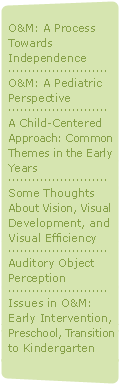|

|
Auditory
Object Perception
by
Joe Cutter
Auditory
Object Perception (AOP) is the utilization of the presence
or absence of reflected sound, which assists the blind
person in locating objects before physical contact (in
his/her own path and to the side) and orienting to a
space by being able to detect objects in that space.
A high frequency sound is produced, so that when an
object is approached, the reflected sound may be heard.
When receding from an object, the frequency is lower.
The magnitude depends upon the velocity of the sound
waves, the movement of the person, etc. The sound heard
is described as a "closeness," "pressure," "shadow,"
or "tunnel" and can be thought of as the "sea shell
effect." In the literature, this is known as "echolocation."
The
state-of-the-art regarding research into the early movement
of blind children and how they come to know their world
is summarized by Dodson-Burke, Hili, and Smith (REVIEW,
Summer 89). They state: "For children two years of age,
familiarity with and knowledge of the structure of external
space may be largely dependent upon movement within
that space." There is virtually no research that links
the quality of movement to the degree to which children
two years old and younger are familiar with their environments.
My
own experience with young blind children and how they
express AOP tells me that it does indeed increase the
quality of movement and orientation during this early—under
two years of age—sensorimotor stage of development
by enabling the child to search out and explore the
world (via sound space exploration) in a more efficient
and meaningful manner. These children develop more autonomy,
postural security, and knowledge of the object world.
The
0&M specialist can introduce—to parents and early
intervention staff—the concept of affordance regarding
appropriate toys for play. Holly Ruff states that "...
the structure and function of an object are critical
to its recognition." The more the object affords the
child, the more invitation the child has to explore.
For example, playing with different size containers
(plastic, metal, cardboard, etc.), dropping objects
into them, holding them up by the child's ear, etc....all
of these activities introduce the blind baby to the
"amusement of the sound space world."

In
the early years, parents are attaching to their baby
through touch affections. Blind babies will give meaning
to sounds through these pleasurable and secure touch
feelings. The match and expectation of loving touch
and human sounds becomes anticipated. The face-to-face
exploration and closeness of parents and baby assist
in the rudimentary development of object permanence—the
precursor being person permanence. Walter Ong writes:
"Touch attests to the objective reality in sense of
something outside myself, and yet the very fact it attests
the not-me more than any other sense, touch involves
my own subjectivity more than any other sense."
AOP
expresses itself more obviously during the locomotion
of very young blind children, specifically around the
event of crawling. This skill is used for self-protection
and a more efficient movement in space, as well as learning
to know the arrangement of the world. (Auditory reach
is the hallmark of object permanence in the blind baby.
Auditory reach will be the precursor to AOP as more
subtle sounds are discriminated, attended to, and experimented
with.)
During
the first year, the blind baby will progress from more
generalized movements to more specific use of hands
and feet. As new walkers, blind toddlers will appear
to "lose" the AOP, thus bumping into objects that may
have been avoided during crawling (e.g., going around
kitchen cabinets or through a door opening). In reality,
however, the new walker still possesses the ability
but it is not at his/her disposal, as the difficulty
of learning the new motor act of walking takes full
use of all sensory systems to maintain balance. As the
toddler develops better balance and postural security,
he/she is able to use what the environment has to offer
in relationship to sound and space and gradually the
similar process is set in motion of experimentation,
and soon the AOP emerges again.
The
cane is a tool that facilitates movement, protects,
detects, makes for more efficient travel, and, to various
degrees, is relied upon for proprioceptive feedback
(one's own feeling of moving body parts) by the child.
The repertoire of motor schemes will expand with AOP
as the cane traveller becomes familiar with the cane.
The 0&M specialist will need to allow the child's natural
need to explore the cane's effect on sound space (e.g.,
the child may excessively tap, bang, or hit the cane
against the ground or object). As the cane skills become
more familiar and the use of AOP increases while ambulating,
these exaggerated movements will decrease.

|

